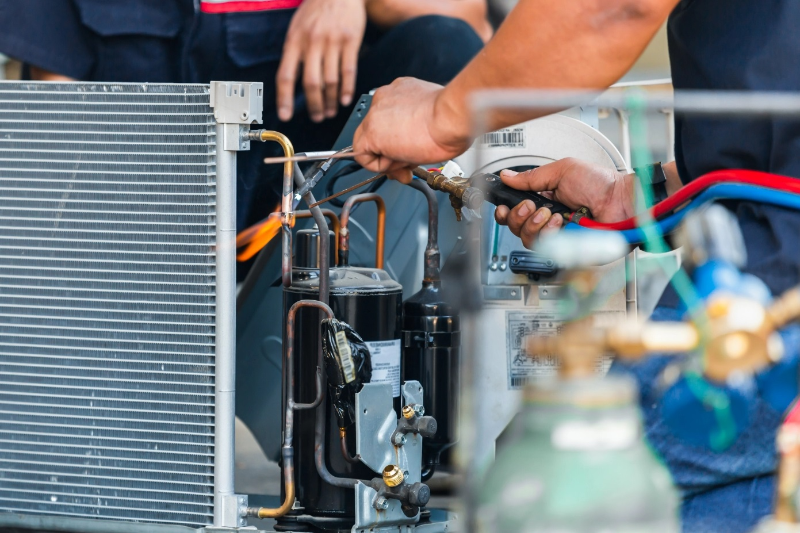Table Of Contents
In the sweltering heat of summer or the chilly days of winter, we rely on air conditioners to keep our indoor spaces comfortable. Among the various types of air conditioning systems available, the reverse cycle air conditioner stands out for its versatility and efficiency.
So, read on to learn more about how a reverse cycle air conditioner works and how professional HVAC technicians are the ones to call if any system issues occur.
How Reverse Cycle Air Conditioners Function
Cooling mode
When you flip the switch on your reverse cycle air conditioner to the cooling mode, a fascinating process begins. The evaporator coil, tucked inside your indoor unit, takes centre stage.
It’s responsible for evaporating a special refrigerant, a chemical compound designed to absorb heat efficiently. As the refrigerant evaporates, it draws heat from the surrounding indoor air, cooling it down.
The compressor then steps in, compressing the now-gaseous refrigerant to increase its temperature. This hot, pressurised gas travels to the outdoor condenser unit, releasing the absorbed heat into the outdoor air and completing the cooling cycle.
Heating mode
When winter arrives, and you crave warmth, your reverse cycle air conditioner switches to its heating mode. Here’s where the magic happens in reverse. The cycle gets reversed, as the name suggests. The outdoor unit’s evaporator coil absorbs heat from the outdoor air, even in cold temperatures.
The refrigerant, now a cold gas, travels indoors to the indoor unit’s condenser coil. As it gets compressed, its temperature rises significantly. This hot refrigerant then circulates through the indoor unit’s coil, transferring its warmth to the indoor air and raising the indoor temperature to your desired level.
Components of a Reverse Cycle Air Conditioner

Refrigerant: The vital medium
The refrigerant is central to the operation of a reverse cycle air conditioner, the special substance that undergoes phase changes to absorb and release heat. Modern split systems use various refrigerants, each with its own benefits and environmental considerations. Regardless of the refrigerant type, they all play a crucial role in facilitating heat exchange.
Evaporator and condenser coils
Picture the evaporator and condenser coils as the workhorses of your reverse-cycle air conditioner. In cooling mode, the evaporator coil transforms the liquid refrigerant into a gas by absorbing heat from your indoor air.
On the other hand, in heating mode, the condenser coil releases heat absorbed from the outdoor air into your indoor space. These coils are designed to maximise heat transfer efficiency, ensuring that your system operates optimally.
Compressor: The heart of the system
Think of the compressor as the heart of your reverse-cycle air conditioner. It compresses the refrigerant, increasing its temperature and pressure, propelling it through heat exchange.
A high-quality compressor is essential for efficient and consistent operation, and some modern split-system air conditioners even feature variable-speed compressors that adjust their output based on cooling or heating needs.
Expansion valve: Regulating the refrigerant flow
While the compressor and coils take centre stage, the expansion valve works diligently behind the scenes. The valve controls the flow of the refrigerant, reducing its pressure and causing it to expand.
As the refrigerant expands, it rapidly cools down, preparing it for the next phase of the heat exchange process. This crucial component ensures that the cycle operates smoothly and efficiently.
Air handling unit and ductwork
The air handling unit, often located within your home, is pivotal in distributing the conditioned air throughout your residential living and commercial office spaces. Connected to a network of ducts, it circulates the cooled or heated air, ensuring that every corner of your home enjoys the desired temperature. Properly designed and maintained ductwork is essential for efficient and consistent airflow, contributing to your comfort.
Benefits of Using Reverse Cycle Air Conditioners

Energy efficiency and cost savings
One of the most appealing aspects of reverse-cycle air conditioners is their energy efficiency, especially compared to traditional heating systems. By leveraging the principles of heat exchange, these systems can deliver a significant amount of heating or cooling using a relatively small amount of energy. This efficiency translates to cost savings on energy bills while reducing your carbon footprint.
Year-round comfort and convenience
Imagine having a single system that can keep you cool during scorching summers and warm during frosty winters. That’s precisely what a reverse-cycle air conditioner offers. With seamless transitions between cooling and heating modes, you won’t need separate heating and cooling systems. This convenience not only saves space but also simplifies maintenance and operation.
Environmental considerations
Are you concerned about the environment? Reverse-cycle air conditioners have an edge here too. By utilising a closed-loop refrigerant cycle, these systems minimise the release of harmful greenhouse gases into the atmosphere.
Practical Tips for Optimal Reverse Cycle AC Usage

Thermostat settings for efficiency
Setting your thermostat at the optimal temperature can significantly impact your reverse-cycle air conditioner’s efficiency. Aim for a comfortable yet moderate indoor temperature during summer, such as 24-26°C (75-78°F).
In winter, aim for around 18-20°C (64-68°F) for heating mode. Utilising programmable thermostats can help you maintain these settings automatically, ensuring efficient operation without unnecessary energy consumption.
Proper maintenance for peak performance
Like any other appliance, routine maintenance is crucial for optimal performance. Start by cleaning or replacing your ACs air filters at recommended intervals to ensure adequate airflow and efficient heat exchange. Schedule professional inspections and air conditioning servicing annually to address potential issues and keep your air conditioning system running smoothly throughout the year.
Zoning and airflow management
Not all rooms in your home have the same heating and cooling needs. Zoning allows you to divide your home into different zones and independently control each temperature. By adjusting airflow to other zones, you can avoid wasting energy on unoccupied areas. This approach ensures you only heat or cool the spaces you use, enhancing comfort and efficiency.
Reverse Cycle AC vs Other Cooling/Heating Systems
Reverse cycle AC vs. traditional heaters
Compared to traditional heating options like gas or electric heaters, reverse-cycle air conditioners offer a clear advantage in terms of energy efficiency. Traditional heaters convert energy into heat, while reverse cycle systems move heat from one place to another, requiring significantly less energy input. This efficiency reduces your energy bills and contributes to a greener environment.
Reverse cycle AC vs. window air conditioners
While window air conditioners are a standard cooling solution for many households, they come with limitations regarding efficiency and aesthetics. Reverse-cycle air conditioners, on the other hand, offer a more versatile and energy-efficient option. With the ability to provide both cooling and heating, along with their discreet indoor installation, they offer a comprehensive and visually appealing solution.
Reverse Cycle AC Innovations and Future Technology

Integration of smart home technology
The era of smart homes is upon us, and reverse-cycle air conditioners are joining the party. Modern systems can be integrated into smart home platforms that allow you to control and monitor your indoor climate remotely. Adaptive learning algorithms enable your system to learn your preferences and adjust settings automatically, optimising comfort and energy efficiency.
Improved energy efficiency and eco-friendly refrigerants
The quest for improved energy efficiency continues, driving reverse-cycle air conditioner technology innovations. Manufacturers constantly refine heat exchange designs and enhance system components to deliver better performance with reduced energy consumption.
Additionally, the development of low GWP refrigerants ensures that these systems are efficient and environmentally friendly. In a world where comfort and environmental responsibility go hand in hand, reverse-cycle air conditioners are a testament to human ingenuity.
They can provide year-round comfort while minimising energy consumption. So, the next time you feel a blast of cool air on a sweltering day or bask in the cosy warmth during winter, remember the intricate process and components that make it all possible.
Embrace the Efficiency of Reverse Cycle AC Units
If you’re looking for a reliable and versatile solution to your heating and cooling needs, consider the benefits of a reverse-cycle air conditioner. Say goodbye to the hassle of switching between heating and cooling systems and embrace the convenience of year-round comfort.
Whether you’re aiming for a more energy-efficient home, a smaller carbon footprint, or a more comfortable living space, reverse cycle air conditioning has you covered. Take the next step towards a more comfortable and eco-friendly lifestyle by consulting with HVAC experts—They can help you explore the options available and make the switch!



